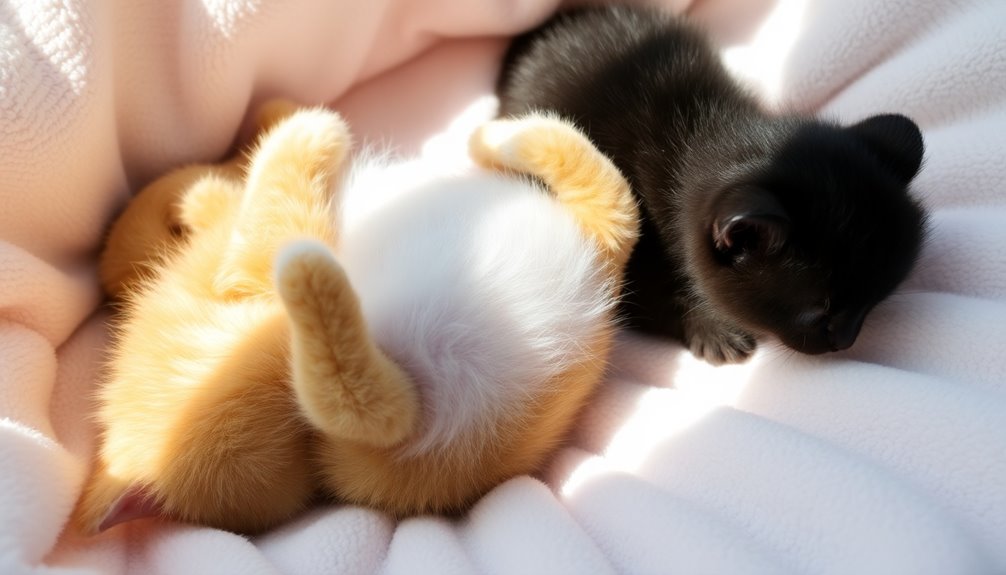To tell the sex of a kitten, you need to closely inspect their genital area. Look for a round opening further from the anus for males and a vertical slit closer for females. Typically, male kittens' openings are about 1/2 inch away from the anus. Around 6 weeks, you might even see visible testicles. If you're unsure, don't worry; mistakes can happen, even among vets. Pay attention to the kitten's behavior too, as males tend to be more playful while females show nurturing habits. Curious about more details? There's plenty more to discover about kitten sexing techniques!
Key Takeaways
- Examine the genital opening: males have a round shape, while females possess a vertical slit closer to the anus.
- Measure the distance: male kittens have a greater distance (about 1/2 inch) between the anus and genital opening than females.
- Look for visible testicles: male kittens may show testicles between 6 to 10 weeks of age, sometimes as early as 6 weeks.
- Observe behavior: male kittens are often more playful and energetic, while females tend to be more nurturing and cautious.
- Consult a veterinarian for accurate sex determination and to address any health concerns specific to the kitten's sex.
Anatomy of Kittens
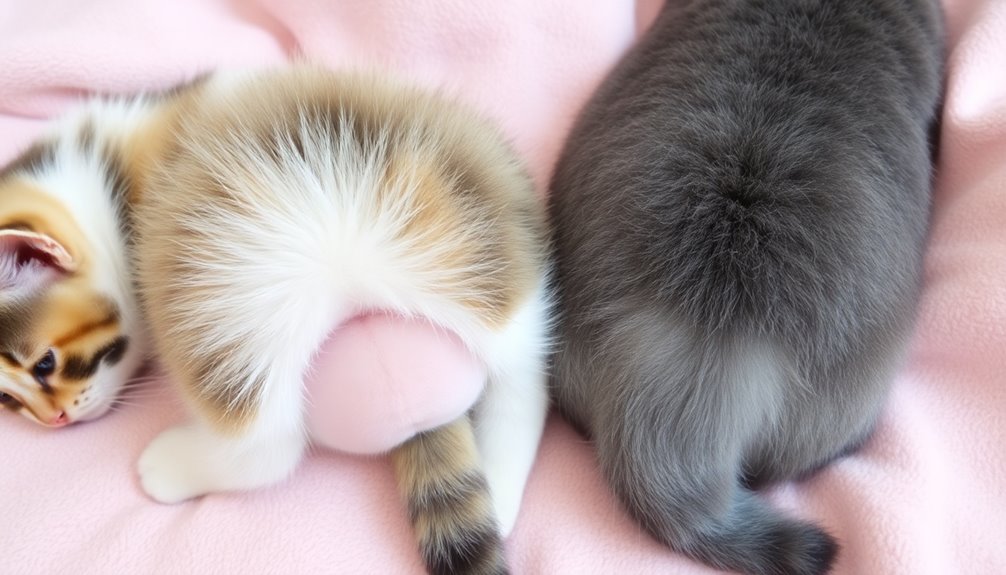
Understanding the anatomy of kittens is essential for determining their sex. When you look closely, you'll notice that male kittens have a round genital opening positioned further from the anus, while female kittens have a vertical slit closer to the anus.
This difference in genital openings is key in identifying whether your kitten is male or female. Additionally, the distance between the anus and the genital opening is greater in males.
As they mature, male kittens will develop visible testicles, typically noticeable between 6 to 10 weeks of age. Tail lifting can help you observe these features more easily, making it easier to distinguish between male and female kittens with practice and observation.
Visual Identification Techniques
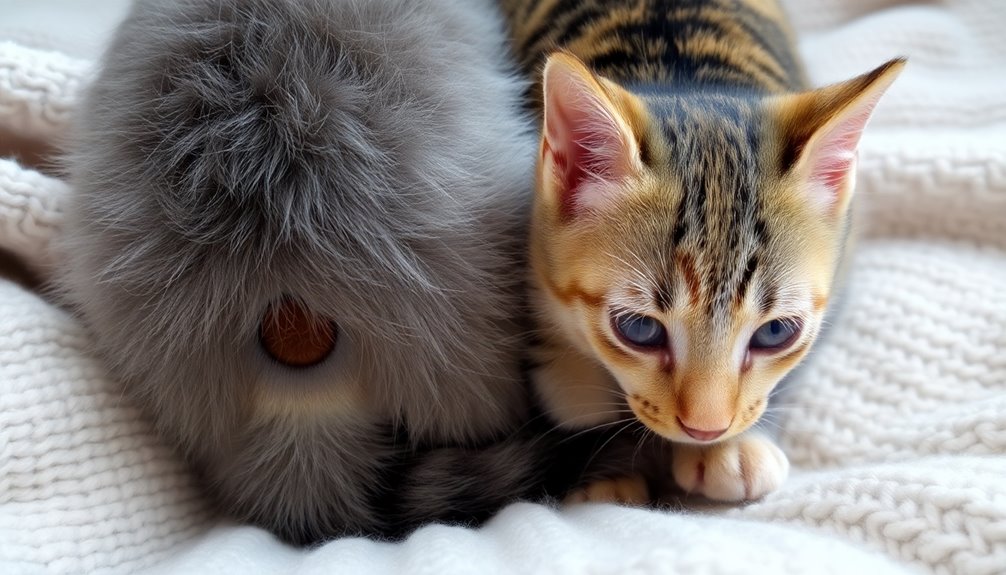
When you're trying to determine a kitten's sex, observing the shape and positioning of their genital opening is essential. Gently lift the tail and look closely: male kittens have a round opening that resembles a circle, while females show a vertical slit, akin to a line or teardrop.
You'll also notice that the distance between the anus and the genital opening is greater in males, usually about 1/2 inch apart. Additionally, male kittens might've extra fur and tissue between these areas, which is less distinct in females.
As you gain experience, observing multiple kittens can help you sharpen your skills in identifying kittens' sex, making the differences more apparent with practice.
Age and Sex Determination
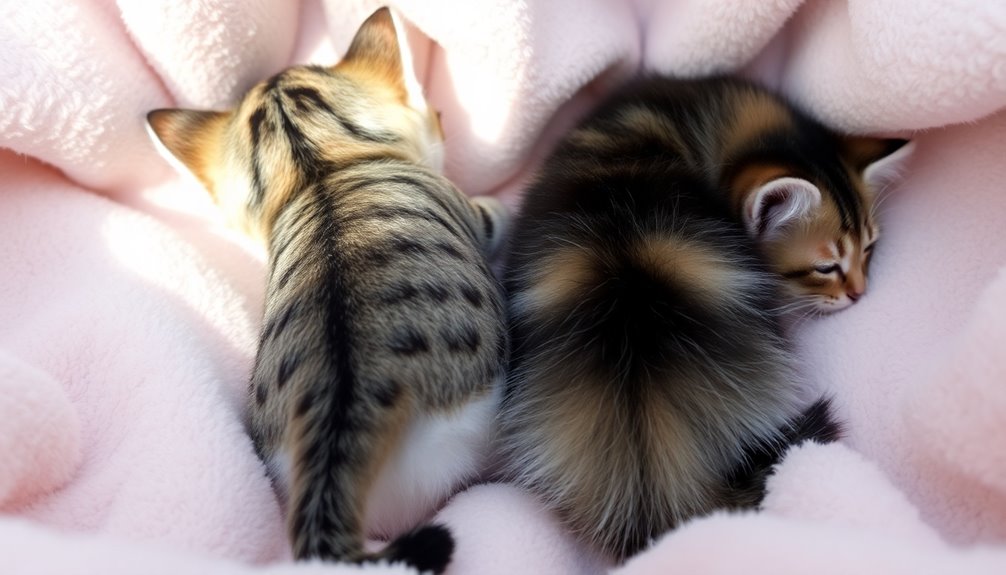
When it comes to determining a kitten's sex, age plays an essential role.
You can start identifying their sex accurately around 8-10 weeks, as their physical traits become clearer.
However, even at 6 weeks, male kittens may show visible testicles, while females will have a distinct slit for their vulva.
Age for Identification
Identifying the sex of a kitten becomes more reliable between 8 to 10 weeks of age, as their physical traits become clearer.
However, you can start noticing differences as early as 4 to 6 weeks. To help you with identification, keep these key points in mind:
- Male kittens may show visible testicles by 6 weeks.
- The distance between the anus and the genital opening is greater in males.
- Female kittens have their openings closer together.
- Mistakes in sex identification can happen, even among vets.
- Full sexual maturity typically occurs by 5 to 6 months.
Developmental Milestones Observed
By 4 to 6 weeks, you'll start noticing significant developmental milestones that indicate a kitten's sex. At this stage, sexual differentiation becomes apparent. By 8 to 10 weeks, you can often see male testicles, making identification more reliable.
Here's a helpful comparison:
| Feature | Male Kittens | Female Kittens |
|---|---|---|
| Anogenital Distance | Greater distance | Shorter distance |
| Genital Opening Shape | Round shape | Vertical slit |
| Testicle Visibility | Typically visible | Not present |
| Behavioral Changes (5-6 mos) | More pronounced | Generally less aggressive |
As they approach 5 to 6 months, behavioral changes also emerge, marking full sexual maturity. Regular health check-ups can aid in monitoring these milestones.
Veterinary Consultation Importance
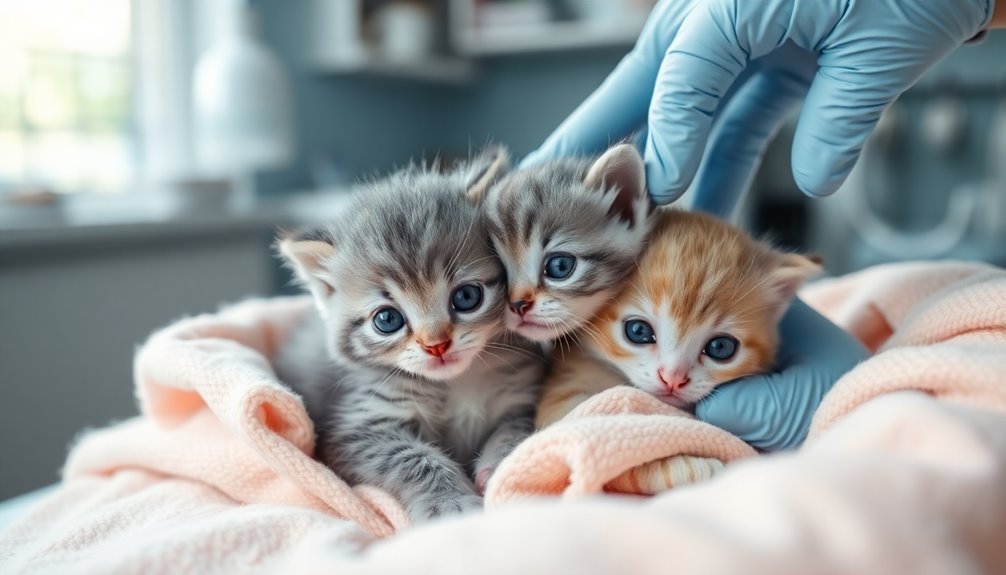
Consulting a veterinarian is essential for accurately determining a kitten's sex, as they provide professional guidance and confirm your findings through a thorough examination.
A veterinary consultation not only helps you identify gender but also guarantees your kitten's overall well-being. Here are some reasons to take into account:
- Clarifies uncertainties in sex identification
- Monitors development and health
- Addresses sex-specific health concerns
- Educates you on behavioral implications
- Fosters responsible pet ownership
Engaging with a vet empowers you to make informed decisions about your kitten's care.
With their expertise, you'll ensure that your furry friend receives the appropriate attention and interventions needed for a healthy life.
Don't hesitate to seek professional help for your kitten's needs!
Identifying Female Kittens

To identify female kittens, start by examining their genital appearance, which resembles a vertical slit or teardrop shape.
You'll also want to measure the anogenital distance; it's much shorter in females than in males.
Finally, keep an eye out for color patterns, as tricolor kittens are usually female due to their genetics.
Genital Appearance Differences
Identifying female kittens can be straightforward when you know what to look for in their genital appearance. Here are some key points to help you identify female kittens' genitals:
- The genital opening appears as a vertical slit or teardrop shape.
- This opening is positioned closely to the anus.
- The distance from the anus to the vaginal opening is shorter in females.
- You'll first see the anus, followed closely by the vaginal opening in females.
- Female kittens typically have less fur around the genital area, making it easier to see.
Anogenital Distance Measurement
When you're trying to determine the sex of a kitten, measuring the anogenital distance can be a reliable method.
In female kittens, this distance is noticeably shorter, with the genital opening positioned closely to the anus—typically less than 1/2 inch apart.
You'll notice that the genital opening appears as a vertical slit or teardrop shape, setting female kittens apart from males.
When you gently examine a female kitten, you'll observe less excess fur and tissue around the genital area, making the identification even clearer.
Color Pattern Indicators
While color patterns aren't foolproof indicators of a kitten's sex, they can provide valuable hints, especially in identifying female kittens.
Here are some key points to take into account:
- Calico and tortoiseshell kittens are mainly female, with about 99.9% being female.
- Look for a mix of colors in a kitten's coat, which often suggests female gender.
- Orange or ginger fur typically indicates a male, as 75% of orange kittens are male.
- Male kittens may show solid or tabby patterns more frequently.
- Always combine color observations with physical characteristics for accurate sex determination.
Identifying Male Kittens

One easy way to tell if a kitten is male is by examining its genital area. Male kittens have a circular genital opening located about 1/2 inch from the anus. The area between the anus and the penis contains more fur and tissue than in females. As they grow, testicles become visible around 6 to 10 weeks, providing a clear indication of their gender. When you look closely, the male's genital area will resemble a circle, not a slit. Palpating the scrotum can confirm their sex; if you feel oval shapes, they're testicles.
| Feature | Male Kittens | Female Kittens |
|---|---|---|
| Genital Opening | Circular | Slit |
| Distance from Anus | ~1/2 inch | ~1/4 inch |
| Fur & Tissue | More excess | Less excess |
| Testicles | Visible at 6-10 weeks | N/A |
| Shape | Circular | Slit |
General Guidelines for Sexing
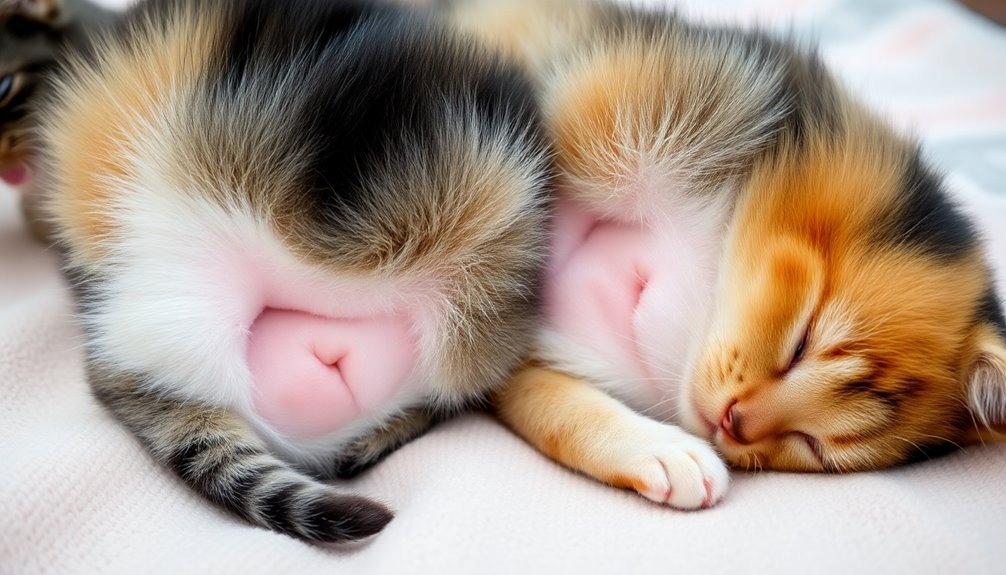
To accurately determine a kitten's sex, start by gently lifting the tail and examining the anogenital area. Here are some guidelines to help you:
- Look for the first opening you see; it's the anus.
- Measure the distance between the anus and the genital opening—it's greater in males.
- Identify the shape: male kittens have a circular opening, while females have a vertical slit.
- Check for testicles, which become visible around 6 to 10 weeks.
- Practice observing multiple kittens to improve your skills.
With these tips, you'll find it easier to distinguish between male and female kittens.
Behavioral Differences in Kittens

When you observe your kittens, you might notice some distinct behavioral differences between males and females.
Male kittens often display a zest for playfulness, engaging in rough-and-tumble antics, while female kittens can show nurturing tendencies, like carrying their favorite toys.
Understanding these behaviors can help you appreciate their unique personalities as they grow.
Male Kitten Playfulness
While female kittens can be playful, male kittens often take it to another level, displaying a higher intensity in their playfulness.
You'll notice they engage in rough play and chase more often as they explore their surroundings.
Here are some key characteristics of male kitten playfulness:
- Wrestling and pouncing to showcase their strength.
- Increased aggressive behavior during playtime.
- A tendency to engage in territorial marking as they mature.
- Roaming behaviors as they instinctively explore.
- The influence of early socialization with siblings to develop social skills.
Understanding these traits will help you better appreciate the exuberance of male kittens as they grow and play!
Female Kitten Nurturing Behaviors
Male kittens may be known for their exuberance, but female kittens bring their own set of fascinating behaviors to the table. They often display nurturing instincts, such as carrying toys in their mouths as early as 10 weeks old. This behavior hints at their maternal side.
When female kittens are in heat, you might notice them vocalizing loudly and seeking attention, which signals their readiness for mating. In new environments, they tend to be more cautious and reserved, contrasting with the boldness of males.
During play, female kittens engage in gentler interactions, showing care during rough play. Additionally, their social interactions often include grooming and cuddling, reflecting their strong instinctual bonding tendencies with littermates or caregivers.
Health Considerations for Kittens
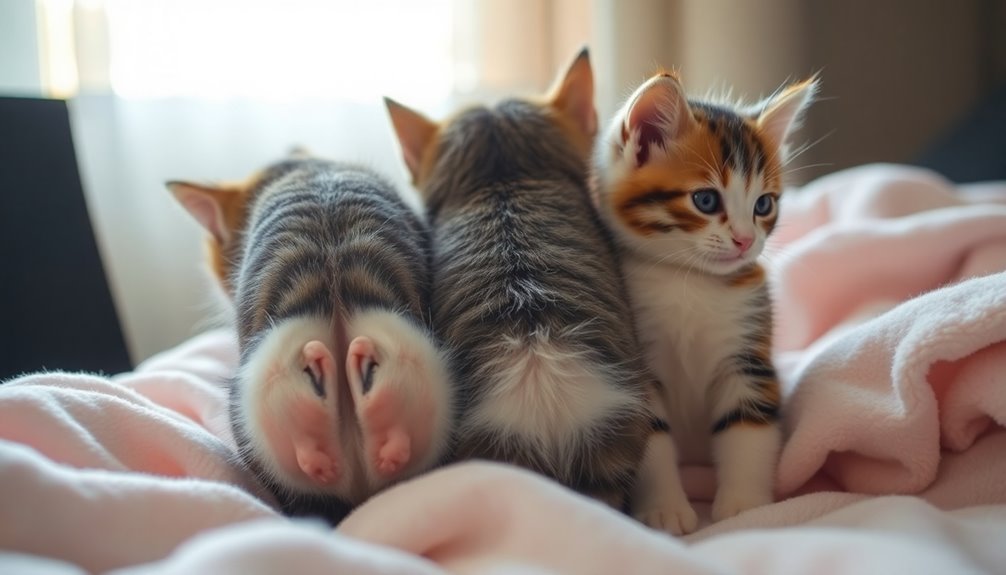
Understanding health considerations for kittens is crucial, as it can considerably impact their well-being.
Male kittens, in particular, require special attention due to certain health risks. Regular vet check-ups are essential for all kittens.
Here are some key health considerations:
- Male kittens are at a higher risk for urinary tract issues if not neutered.
- Spaying female kittens helps prevent serious conditions like pyometra.
- Monitor behavior differences between male and female kittens.
- Early spaying or neutering can positively influence growth and behavior.
- Common health issues like ringworm and flea infestations affect both sexes.
Additional Resources for Owners
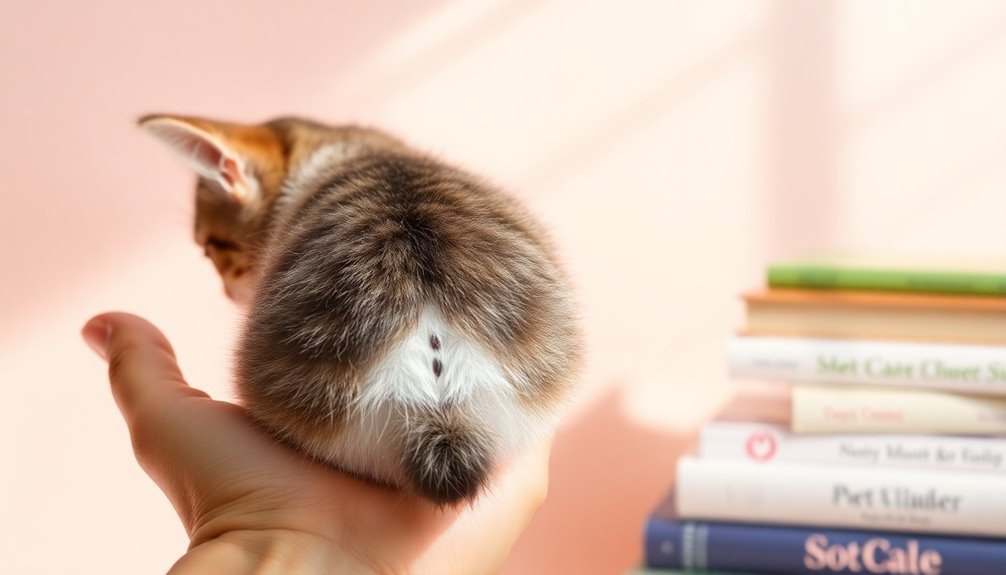
You can find valuable additional resources for owners online, like the Kitten Lady website, which offers visual galleries to help you distinguish their sex. Downloadable fact sheets on kitten sexing make handy references for quick identification.
For precise guidance, consider consulting your veterinarian, who can address health concerns related to the kitten's sex. Staying informed is easier when you subscribe to newsletters like HumanePro News for best practices. Additionally, open communication with other pet owners can enhance your understanding of both sex determination and overall care.
Joining community support groups and forums allows you to share experiences and gain tips from other kitten owners, enhancing your understanding of both sex determination and overall care.
Frequently Asked Questions
How Do You Tell the Gender of a Kitten?
To tell the gender of a kitten, you need to examine the area under its tail.
Gently lift the tail and look at the genital region. If you see a round opening further from the anus, it's likely male. A vertical slit closer to the anus indicates a female.
Keep in mind the distance between these areas; it's greater in males. With a little practice, you'll get the hang of it!
What Does a Female Kitten's Private Look Like?
Imagine spotting a tiny treasure hidden in a soft fur coat.
When you take a closer look at a female kitten's private area, you'll notice it's shaped like a vertical slit or teardrop, nestled close to the anus.
The space between these two points is shorter compared to males.
With less fur surrounding this area, it's like finding a clue in a mystery, making it easier for you to identify her.
How Do I Know if My Kitten Has Sex?
To know if your kitten has a specific sex, you'll want to observe closely.
Gently lift the tail and look at the area below. A male kitten usually has a round opening further from the anus, while a female's is slit-shaped and closer.
As your kitten grows, these features become clearer, especially around 8 weeks.
How Do You Tell the Difference Between a Boy and a Girl Cat?
To tell the difference between a boy and a girl cat, you'll want to observe a few key features.
Look at the spacing between their anus and genitalia; males have more distance. Check the shape of the genital opening: males' look like a circle, while females' resemble a vertical slit.
You can also consider color patterns—calico or tortoiseshell cats are usually female.
Gently lift the tail for a better view in good lighting.
Conclusion
In the world of kittens, knowing their sex is like revealing a treasure chest of knowledge that helps you care for them better. By using visual identification techniques and understanding their anatomy, you can confidently determine whether your furry friend is a boy or a girl. Don't hesitate to consult a vet if you're unsure, as their expertise is invaluable. With this newfound knowledge, you're better equipped to nurture your little companion and watch them thrive.

